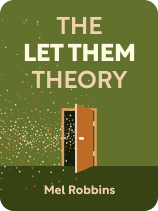

This article is an excerpt from the Shortform book guide to "The Let Them Theory" by Mel Robbins. Shortform has the world's best summaries and analyses of books you should be reading.
Like this article? Sign up for a free trial here.
Do you know what the Let Them Theory is? How can you apply the theory in all areas of your life?
Having a deep need to control is an exercise in futility that only makes us frustrated and anxious and sets us up for conflict with the people in our lives. Mel Robbins contends that we need to shift our mindsets so we can stop wasting energy trying to control other people by using the Let Them Theory.
To learn how to use the Let Them Theory, read below for the two-step process.
How Can You Use the Let Them Theory?
Robbins contends that the Let Them Theory can be applied to all areas of your life, from work to friendships to romantic relationships. At its core, learning how to use the Let Them Theory is a two-step process:
1. Recognize and acknowledge situations or behaviors that are outside your control. In these moments, when you notice you’re reacting negatively to someone’s choices, consciously say “Let Them” to yourself, signaling your detachment from judging them and letting go of your need to change, control, or criticize them.
2. Shift your focus to what you can control: your thoughts, actions, and responses. Reflect on how you want to think, act, and speak, and how you can align your next steps with your core values. Say “Let Me” and take a deep breath, resetting your body’s stress response, and reclaim your responsibility to act positively.
| Sailing Against the Wind The Let Them Theory has a parallel in sailing, an activity where success depends entirely on working with forces you cannot control. Sailors understand a fundamental truth: You cannot sail directly against the wind. Attempting to do so leaves you stalled and frustrated, just as trying to change other people’s behaviors leaves you drained and ineffective. Instead, skilled sailors use a technique called “tacking,” where they zigzag at strategic angles to the wind, making forward progress through indirect routes. This strategy perfectly illustrates Robbins’s approach to navigating the headwinds of your relationships with other people. When sailors encounter a headwind, they first assess its direction and strength, similar to Robbins’s “Let Them” step, where you acknowledge reality as it exists. Then, rather than fighting the wind directly, sailors adjust their sails and direction to harness that same force to move forward—just as the “Let Me” step redirects your energy toward productive action within your control. The physics behind this approach is revealing: A sail works by creating pressure differences that generate forward movement, but only when properly positioned relative to the wind. Similarly, our efforts in life generate momentum only when we stop fighting unchangeable realities and instead position ourselves strategically in relation to them. Skilled sailors don’t waste energy cursing the wind’s direction. They simply adjust their course and sails. |
Robbins explains that you can use the Let Them Theory to manage the stress of your everyday life more productively. When you’re feeling annoyed and stressed by your friends’ constantly changing plans, your colleague’s difficulty meeting a deadline, the crowd at the grocery store, or the person having a loud conversation on the train, that’s the perfect time to say, “Let Them.” Robbins writes that these stressors automatically activate your brain’s stress response but by stopping and thinking “Let Them,” you can reset this response to signal to your brain that whatever’s happening isn’t worth getting stressed over.
This method helps you take control of how you spend your time and energy. When you remind yourself to let other people manage their actions, you stop yourself from letting their behavior amp up your stress levels and bring down your mood. Then, when you refocus on what you’re going to say or do in the situation, you signal to your brain that you can’t control the situation you’re feeling stressed about—but you can control how you respond. As for figuring out how to respond, Robbins recommends considering whether the incident will bother you in an hour, or a week, or a year: If it won’t, then you might not have to do anything. But if it’s really going to bother you, then it’s worth putting in the time and effort to change it.
| How to Interrupt the Stress Response When Robbins suggests saying “Let Them” to reset your stress response, she’s tapping into something neuroscientists have been studying for decades: our ability to interrupt the body’s automatic stress cascade. Stress triggers a rapid sequence of events in your brain: Your amygdala (a brain region involved in emotional processing) perceives a threat and signals the hypothalamus, which works like a command center and activates your sympathetic nervous system. This releases adrenaline and eventually cortisol into your bloodstream. This “fight-or-flight” response evolved to help you survive physical dangers. But it gets activated by everyday frustrations too, like that person talking loudly on their phone in public. The “Let Them” technique works by engaging your prefrontal cortex, the rational part of your brain responsible for higher-order thinking. When you consciously say “Let Them,” you’re activating this region, which can interrupt the amygdala’s emotional alarm system. This mental shift helps your parasympathetic nervous system (the “brake” to your stress response) engage more quickly. Researchers describe getting “stuck” in the fight-or-flight response as failing to complete the stress cycle. When you use Robbins’s method to accept what you can’t control and refocus on your own response, you’re actually helping your brain complete this cycle by transitioning from stress activation to relief. This also explains why Robbins finds that saying “Let Them” and “Let Me” helps people to conserve mental energy. Instead of maintaining the physiologically expensive stress response (which both drains cognitive resources and depletes physical energy), you’re allowing your body to return to baseline functioning sooner. This also has the effect of keeping your prefrontal cortex online for more important tasks. |
Ahead, we’ll consider how applying the Let Them theory can help you improve your relationships with others and even with yourself.
Take Control of Your Relationships
Saying “Let Them” and “Let Me” gives you a way to take responsibility for your relationships. Other people’s words and actions can send us on an emotional rollercoaster: When we internalize the negative things they say and do, we often feel inferior. For example, if your colleague walks into the office one morning and immediately snaps at you, you’d likely feel you must have done something wrong that justifies their rudeness. But they might just be in a bad mood because their shoelace broke or they missed their train—circumstances that don’t involve you.
Conversely, as we discussed earlier, it can make you feel superior to just think “let them” and dismiss your colleague’s behavior—thinking you’re the bigger person who’s above such pettiness or judging them for being rude. But that wouldn’t be a productive way forward, as it still involves judgment rather than true acceptance.
Robbins explains that you’re responsible for building the relationships you want with other people. In the situation with your grumpy colleague, that means that you wouldn’t respond to their rudeness in kind, but instead look at them with empathy and figure out how you can make their day better. Robbins notes that if you say “Let Them” without following it up with “Let Me,” then you can end up feeling isolated from others. It’s by saying “Let Me” that you exercise your agency to be the person you want to be—for example, the kind of coworker who speaks to your colleagues with the consideration they deserve.
The same principle applies to friendships, too: Robbins explains you have to create the community you desire by adapting to the evolution of your friendships over time. When friends move away, prioritize new connections, or have less time for you, you need to say “Let Them” instead of clinging tightly or feeling hurt. At the same time, use “Let Me” to consider what matters most in adult friendships: proximity, timing, and energy. Proximity refers to physical closeness, which creates opportunities for interaction. Timing involves being at similar life stages. Energy is the effort you put in nurturing the friendship. If these are lacking, you can take action to realign yourself with a friend who seems distant—or make new connections.
Robbins notes that you can take the same approach to romantic relationships as well. When you’re dating someone, you have to “Let Them” show you who they really are, what they want in life, and whether you’re a priority to them. If they’re not the kind of person you want to be with, then you can let the relationship go to make space for someone else who can offer the love, commitment, and compatibility you deserve. No relationship is perfect, and every relationship hits rough patches. But if you agree on your values and support each other’s dreams, are willing to put in the effort to make the relationship work, and can accept each other as you are, then you can love them for who they are rather than for who you wish they could be.
Stop Being Stressed Out by Other People’s Opinions
The Let Them Theory also works when it’s what other people think and say—rather than what they do—that stresses you out. Inevitably, people will have and express negative opinions about you. But if you let their opinions influence your decisions, then you give up control over what you do with your life. Robbins points out that just as we can’t change what thoughts pop into our own heads, it’s impossible to control what other people think. She recommends expecting that other people will think negative thoughts about you—and resolving to follow your own path anyway. Instead of letting your fear of other people’s negative opinions constrain you, you can make decisions you’re proud of and live according to your own values.
Navigating other people’s opinions can be especially difficult when those other people are your family since they’re with you for the long haul. Robbins explains that it’s important to think about why someone might have the opinion they do of you or your choices. That way, you can see things from their point of view—not so you can change their mind. (You probably won’t.) Rather, it’s so you can respect their perspectives, which were formed by their life experiences, and accept them as their imperfect (and perhaps judgmental) selves. This serves to deepen your relationship.
Let Go of Your Fear of Other People’s Emotional Reactions
In the same way that managing other people’s negative opinions isn’t your responsibility, it’s also not your responsibility to manage other people’s emotional reactions. When you make decisions to avoid disappointing someone, to keep someone from getting angry at you, or because you know they’ll make you feel guilty if you don’t, you’re letting other people’s emotions dictate your decisions. Robbins explains that it’s hard but necessary to set boundaries and “Let Them” react. In doing so, you give people space to feel their emotions, and you release yourself from feeling like you have to manage or fix those emotions for them.
She explains that most people have the emotional maturity of an eight-year-old: They’ve never learned to process their emotions and communicate their needs in a healthy way because many parents inadvertently teach their children to suppress their emotions instead of finding a healthy way to express them. But Robbins explains that when an adult wants to act like an eight-year-old, you should just “Let Them.” Then, when you remind yourself to “Let Me” decide how to respond, you realize that their emotions aren’t yours to manage and it’s up to you to choose how much time and energy you want to give them.
Robbins points out that sometimes, we’re the ones who are being emotionally immature. The Let Them Theory not only helps you feel more compassionate with people who have trouble managing their emotional reactions, but can also help you be more compassionate with yourself and your emotions. When you notice yourself getting angry or feeling frustrated, you can use “Let Them” to tell yourself to let those emotions wash over you. Then, you can use “Let Me” to remind yourself that you don’t have to react to the emotions you feel. You can’t control how you feel, but you can control what you say and do. You shouldn’t let your emotions dictate your decisions any more than you should let other people’s emotions determine what you do.
Stop Pressuring Other People to Change
If you’ve ever tried to push somebody else to change, then you know it almost never works. Instead, you have to create an environment of acceptance and love to enable people to make changes in their own time. We all have a fundamental need for autonomy and control over our lives, and we naturally resist attempts by others to force change because these attempts threaten this core need. However, when we feel fully accepted and loved unconditionally, we’re free to look inward and find our own motivation to grow.
Robbins recommends several steps to create this supportive environment: Practice radical acceptance of others without judgment, express unconditional love while separating who they are from behaviors you dislike, be patient as change happens naturally, celebrate positive steps, and provide resources only when asked. By modeling the positive changes you’d like to see rather than criticizing or controlling, you allow them space to decide for themselves that they want to change. The goal isn’t to enable self-destructive behavior but to provide the emotional safety that makes meaningful change possible. Paradoxically, when people feel truly accepted as they are, they become more willing and able to transform themselves.
Build a Healthier Relationship With Yourself
Finally, Robbins explains that you can use the Let Them Theory to improve the relationship you have with yourself. She notes that you are the only person that you’re guaranteed to spend the rest of your life with, and you owe it to yourself to make your happiness and dreams a priority. When you let other people do what they want to do (and resolve to not allow them to determine what you do), you decide to build the life you want without worrying about other people’s approval or validation. Robbins notes you can use “Let Them” and “Let Me” to give yourself the power to become your own source of happiness, to define what’s important to you, and to take control of how you work to turn your reality into the life you want.

———End of Preview———
Like what you just read? Read the rest of the world's best book summary and analysis of Mel Robbins's "The Let Them Theory" at Shortform.
Here's what you'll find in our full The Let Them Theory summary:
- A simple but powerful framework for reclaiming your time and mental energy
- How to detach from situations and behaviors that are outside your influence
- How the "let them" theory can be taken too far, and how to avoid it from happening






